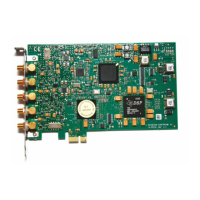WAVECOM Decoder W74PC, W-PCI/e, W-CODE, W-CLOUD Manual V9.1.0 Transmission Modes
217
Automatic frequency control (AFC):
ITA-5 with block coding
HEX (Binary Output)
In contrast to PACTOR-II, modulation and block length in PACTOR-II-FEC is fixed to "DQPSK LONG
BLOCK". Where PACTOR-II uses ARQ, i.e., after each block sent, an acknowledge message from the re-
ceiving station is required, PACTOR-II-FEC has no acknowledge return channel. Thus, the receiving station
must be able to do all the error correction. This is achieved by using a Viterbi decoder with k = 9 and code
rate = ½. Interleaving protects the transmission against fading. Using a DQPSK modulation is a good
compromise when looking at the amount of bits transmitted and the necessary signal-to-noise-ratio.
To extract the data from a PACTOR-II-FEC signal, the signal is received and demodulated with a two
channel DPSK-demodulator. The center frequency must be adjusted to the midpoint between the two
channels. To achieve the best performance, the AFC (automatic frequency control) should be enabled. Af-
ter the demodulation and the bit synchronization, the symbols of the two channels are combined to one bit
stream. After the modulation type has been determined, the resulting bit stream is de-interleaved, passed
through a Viterbi decoder and the CRC is checked.
PACTOR-II-FEC uses the same compression algorithms and CRC masks as PACTOR-II.
Options | CRC Recognition. The detected CRC is displayed in the decoder status bar, see “CRC Recogni-
tion” on page 39.
Using Options | CRC Table a certain CRC mask can be defined, see “CRC Table” on page 39.
Tuning a PACTOR-II-FEC signal
See “PACTOR-II” on page 215.
PACTOR-III
PACTOR-III is an adaptive transmission mode that provides higher throughput and improved robustness
compared to PACTOR-I and –II, both designed for operation within a bandwidth of 500 Hz. To achieve the
improved features, PACTOR-III uses up to a maximum of 18 tones spaced 120 Hz, thus occupying a max-
imum bandwidth of 2160 Hz. Six so-called Speed Levels (SL) are specified, which are predefined combi-
nations of modulation type (DBPSK or DQPSK), channel coding and number of tones (2, 6, 14, 16, or 18)
as well as positions of tones. For all Speed Levels, the modulation rate of each tone is 100 Bd.
Half-duplex synchronous ARQ
DBPSK, DQPSK; 2, 6, 14, 16, or 18 tones

